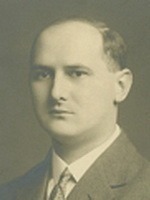| Revision as of 04:05, 18 December 2024 editShyamal (talk | contribs)Autopatrolled, Administrators98,476 edits startTag: Visual edit | Revision as of 04:47, 18 December 2024 edit undoShyamal (talk | contribs)Autopatrolled, Administrators98,476 editsNo edit summaryNext edit → | ||
| Line 2: | Line 2: | ||
| '''Leopold "Leo" Heyrovský''' (November 25, 1892 – June 29, 1976) was a Czech lawyer and entomologist. He specialized in the long-horned beetles of the region. He was the brother of the Nobel Prize winning chemist ]. | '''Leopold "Leo" Heyrovský''' (November 25, 1892 – June 29, 1976) was a Czech lawyer and entomologist. He specialized in the long-horned beetles of the region. He was the brother of the Nobel Prize winning chemist ]. | ||
| Heyrovský was born in ] where his father Dr Leopold Heyrovský (1852–1924) was professor of law. He had four other siblings including his older brother Jaroslav who won the Nobel Prize in chemistry in 1959. After studying at the Gymnasium in Prague, he followed his father to study law at the ]. His studies were interrupted by World War I and he joined military service in 1915, posted into the South Tyrol. He was demobilized at the end of the war with the rank of a cavalry captain and completed his education. He worked in the ministry of education in 1920 and then practiced law. He was deeply involved in his entomological pursuits, becoming a member of the Czech Entomology Society from 1908. During World War II, he collected beetles across Europe and northern Africa, adding nearly 8000 specimens. Many species have been described from his collections including ''Alocoderus heyrovskyi'' Balthasar, 1935 and ''Harpalus heyrovskyi' Jedlička, 1928. He wrote a monograph of the Cerambycidae of Czechoslovakia in 1955. His collected are in the National Museum in Prague and partly in the Silesian Museum in Opava.<ref>{{cite journal|author=Špaček, Klemens |title=Über die wissenschaftliche Tätigkeit des Dr. Leo Heyrovsky.|pages=37-50|journal=Entomologisches Nachrichtenblatt| volume=10| issue=1| year=1936 |url=https://www.zobodat.at/biografien/Heyrovsky_Leo_Ent-Nachrbl-Troppau_10_0037-0050.pdf }}</ref> | Heyrovský was born in ] where his father Dr Leopold Heyrovský (1852–1924) was professor of law. He had four other siblings including his older brother Jaroslav who won the Nobel Prize in chemistry in 1959. After studying at the Gymnasium in Prague, he followed his father to study law at the ]. His studies were interrupted by World War I and he joined military service in 1915, posted into the South Tyrol. He was demobilized at the end of the war with the rank of a cavalry captain and completed his education. He worked in the ministry of education in 1920 and then practiced law. He was deeply involved in his entomological pursuits, becoming a member of the Czech Entomology Society from 1908. During World War II, he collected beetles across Europe and northern Africa, adding nearly 8000 specimens. Many species have been described from his collections including ''Alocoderus heyrovskyi'' Balthasar, 1935 and ''Harpalus heyrovskyi'' Jedlička, 1928. He wrote a monograph of the Cerambycidae of Czechoslovakia in 1955. His collected are in the National Museum in Prague and partly in the Silesian Museum in Opava.<ref>{{cite journal|author=Špaček, Klemens |title=Über die wissenschaftliche Tätigkeit des Dr. Leo Heyrovsky.|pages=37-50|journal=Entomologisches Nachrichtenblatt| volume=10| issue=1| year=1936 |url=https://www.zobodat.at/biografien/Heyrovsky_Leo_Ent-Nachrbl-Troppau_10_0037-0050.pdf }}</ref> | ||
| == References == | == References == | ||
Revision as of 04:47, 18 December 2024

Leopold "Leo" Heyrovský (November 25, 1892 – June 29, 1976) was a Czech lawyer and entomologist. He specialized in the long-horned beetles of the region. He was the brother of the Nobel Prize winning chemist Jaroslav Heyrovský.
Heyrovský was born in Prague where his father Dr Leopold Heyrovský (1852–1924) was professor of law. He had four other siblings including his older brother Jaroslav who won the Nobel Prize in chemistry in 1959. After studying at the Gymnasium in Prague, he followed his father to study law at the Charles University of Prague. His studies were interrupted by World War I and he joined military service in 1915, posted into the South Tyrol. He was demobilized at the end of the war with the rank of a cavalry captain and completed his education. He worked in the ministry of education in 1920 and then practiced law. He was deeply involved in his entomological pursuits, becoming a member of the Czech Entomology Society from 1908. During World War II, he collected beetles across Europe and northern Africa, adding nearly 8000 specimens. Many species have been described from his collections including Alocoderus heyrovskyi Balthasar, 1935 and Harpalus heyrovskyi Jedlička, 1928. He wrote a monograph of the Cerambycidae of Czechoslovakia in 1955. His collected are in the National Museum in Prague and partly in the Silesian Museum in Opava.
References
- Špaček, Klemens (1936). "Über die wissenschaftliche Tätigkeit des Dr. Leo Heyrovsky" (PDF). Entomologisches Nachrichtenblatt. 10 (1): 37–50.